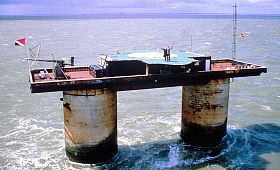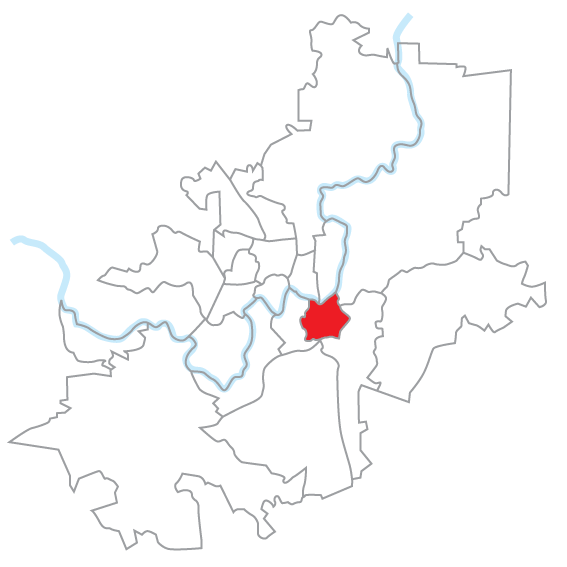|
Užupis
Užupis (, , , ) is a neighborhood in Vilnius, the capital of Lithuania, largely located in Vilnius's old town, a UNESCO World Heritage Site. Užupis means "beyond the river" or "the other side of the river" in the Lithuanian language and refers to the Vilnia River; the name Vilnius was derived from the Vilnia. The district has been popular with artists for some time, and has been compared to Montmartre in Paris and to Freetown Christiania in Copenhagen, due to its bohemian and laissez-faire atmosphere. On April 1, 1997, the district declared itself an independent republic (the Republic of Užupis), with its own constitution. Geography Užupis is quite small and isolated, being only about in size; it has around 7,000 inhabitants, nearly 1,000 of which are artists. On one side it is separated from the Old Town by the Vilnia River, on the second there are steep hills, and on the third side, it borders on an industrial area built under Soviet rule. The first bridges acros ... [...More Info...] [...Related Items...] OR: [Wikipedia] [Google] [Baidu] |
Vilnius
Vilnius ( , ) is the capital of and List of cities in Lithuania#Cities, largest city in Lithuania and the List of cities in the Baltic states by population, most-populous city in the Baltic states. The city's estimated January 2025 population was 607,667, and the Vilnius urban area (which extends beyond the city limits) has an estimated population of 747,864. Vilnius is notable for the architecture of its Vilnius Old Town, Old Town, considered one of Europe's largest and best-preserved old towns. The city was declared a World Heritage Site, UNESCO World Heritage Site in 1994. The architectural style known as Vilnian Baroque is named after the city, which is farthest to the east among Baroque architecture, Baroque cities and the largest such city north of the Alps. The city was noted for its #Demographics, multicultural population during the Polish–Lithuanian Commonwealth, with contemporary sources comparing it to Babylon. Before World War II and The Holocaust in Lithuania, th ... [...More Info...] [...Related Items...] OR: [Wikipedia] [Google] [Baidu] |
Jewish Cemetery, Vilnius
The Jewish cemeteries of Vinius are the three Jewish cemeteries of the Lithuanian Jews living in what is today Vilnius, the capital of Lithuania, which was known to them for centuries as Vilna, the principal city of the Grand Duchy of Lithuania and the Pale of Settlement of the Russian Empire. Two of the cemeteries were destroyed by the Soviet regime and the third is still active. The oldest and the largest Jewish cemetery was established in the 15th century in Šnipiškės suburb, now in Žirmūnai elderate, across the Neris River from the Gediminas Tower. In Vilna Jewish culture, the cemetery was known as Piramont. It was closed by the Tsarist authorities in 1831. It was destroyed by the Soviet authorities in 1949–50 during the construction of Žalgiris Stadium. The Vilnius Palace of Concerts and Sports (Lithuanian: ''Koncertų ir sporto rūmai'') was built in 1971 right in the middle of the former cemetery. In 2005, apartment and office buildings were built at the sit ... [...More Info...] [...Related Items...] OR: [Wikipedia] [Google] [Baidu] |
Micronation
A micronation is a polity, political entity whose representatives claim that they belong to an independent nation or sovereign state, but which lacks legal recognition by any sovereign state. Micronations are classified separately from list of states with limited recognition, de facto states and quasi-states; they are also not considered to be autonomous administrative division, autonomous or self-governance, self-governing as they lack the legal basis in international law for their existence. The activities of micronations are almost always trivial enough to be ignored rather than disputed by the established nations whose territory they claim—referred to in micronationalism as ''macronations''. Several micronations have issued coins, flags of micronations, flags, postage stamps, Fantasy passport, passports, medals and other state-related items, some as a source of revenue. Motivations for the creation of micronations include theoretical experimentation, political protest, ar ... [...More Info...] [...Related Items...] OR: [Wikipedia] [Google] [Baidu] |
Bernardine Cemetery
The Bernardine Cemetery (, ), is one of the three oldest cemeteries in Vilnius, Lithuania. It covers about 38,000 square metres and has an estimated 14,000 burial sites. It was established in 1810 by the Bernardine monks of the Church of St. Francis of Assisi, just east of the city center in the Užupis district, and is situated on an embankment of the Vilnia river. Its development was a consequence of Tsarist authorities of the Russian Empire prohibiting burying the dead near churches. The residents of Vilnius moved the cemetery to what was then the outskirts of the city. The Columbaria were built on the east and west sides of the cemetery. The cemetery was expanded in 1860. After the Second World War the cemetery was abandoned for the most part and began to deteriorate. It was closed in the 1970s and since then until recently it had remained almost unchanged. Many of the oldest graves had sunk into the ground and became covered in moss. The eastern columbarium had almost ... [...More Info...] [...Related Items...] OR: [Wikipedia] [Google] [Baidu] |
Vilnia River
The Vilnia (also Vilnelė; , ''Vilnia'' ; ) is a river primarily running through Eastern Lithuania. Its source is near the villages of and , 6 km south of Šumskas, nearby to the A3– M7 Medininkai–Kamenny Log border crossing complexes of the Belarus–Lithuania border for approximately 12 kilometers. Geography The Vilnia is 79.6 km long and its basin covers 624 sq. km. The river's steepness is 124.6 metres from the source to the mouth. For 13 km, its flow marks the Belarus-Lithuania border, and the remaining 69 km are in Lithuania where it flows into the Neris River at Vilnius. Eventually, its waters, via the Neris draining into the Neman River, reach the Baltic Sea. Its confluence with the Neris lies within the city of Vilnius, and the river's name is regarded to have been the source of the city's name. Sources The springs along the Vilnia's length contribute to its flow. Locals refer to the river's starting source as the Holy Stream ... [...More Info...] [...Related Items...] OR: [Wikipedia] [Google] [Baidu] |
Vilnius Old Town
The Old Town of Vilnius (), one of the largest surviving medieval old towns in Northern Europe, as inscribed within UNESCO World Heritage Sites, has an area of 3.59 square kilometres (887 acres). It encompasses 74 quarters, with 70 streets and lanes numbering 1487 buildings with a total floor area of 1,497,000 square meters. The administrative division of the Old Town (senamiesčio seniūnija) is a larger territory and comprises more than 4.5 square kilometres. It was founded by the Lithuanian Grand Duke and King of Poland Jogaila in 1387 on the Magdeburg rights the oldest part of the Lithuanian capital of Vilnius, it had been developed over the course of many centuries, and has been shaped by the city's history and a constantly changing cultural influence. It is a place where some of Europe's greatest architectural stylesGothic architecture, gothic, Renaissance architecture, renaissance, Baroque architecture, baroque and Neoclassical architecture, neoclassicalstand side by side ... [...More Info...] [...Related Items...] OR: [Wikipedia] [Google] [Baidu] |
Lithuania
Lithuania, officially the Republic of Lithuania, is a country in the Baltic region of Europe. It is one of three Baltic states and lies on the eastern shore of the Baltic Sea, bordered by Latvia to the north, Belarus to the east and south, Poland to the south, and the Russian exclave, semi-exclave of Kaliningrad Oblast to the southwest, with a Maritime boundary, maritime border with Sweden to the west. Lithuania covers an area of , with a population of 2.89 million. Its capital and largest city is Vilnius; other major cities include Kaunas, Klaipėda, Šiauliai and Panevėžys. Lithuanians who are the titular nation and form the majority of the country's population, belong to the ethnolinguistic group of Balts and speak Lithuanian language, Lithuanian. For millennia, the southeastern shores of the Baltic Sea were inhabited by various Balts, Baltic tribes. In the 1230s, Lithuanian lands were united for the first time by Mindaugas, who formed the Kingdom of Lithuania on 6 July ... [...More Info...] [...Related Items...] OR: [Wikipedia] [Google] [Baidu] |
Prostitution
Prostitution is a type of sex work that involves engaging in sexual activity in exchange for payment. The definition of "sexual activity" varies, and is often defined as an activity requiring physical contact (e.g., sexual intercourse, non-penetrative sex, manual sex, oral sex, etc.) with the customer. The requirement of physical contact also creates the risk of transferring infections. Prostitution is sometimes described as sexual services, commercial sex or, colloquially, hooking. It is sometimes referred to euphemistically as "the world's oldest profession" in the English-speaking world. A person who works in the field is usually called a prostitute or '' sex worker'', but other words, such as hooker and whore, are sometimes used pejoratively to refer to those who work in prostitution. The majority of prostitutes are female and have male clients. Prostitution occurs in a variety of forms, and its legal status varies from country to country (sometimes from region ... [...More Info...] [...Related Items...] OR: [Wikipedia] [Google] [Baidu] |
Graffiti Užupis Vilnius
Graffiti (singular ''graffiti'', or ''graffito'' only in graffiti archeology) is writing or drawings made on a wall or other surface, usually without permission and within public view. Graffiti ranges from simple written "monikers" to elaborate wall paintings, and has existed since ancient times, with examples dating back to ancient Egypt, ancient Greece, and the Roman Empire. Modern graffiti is a controversial subject. In most countries, marking or painting property without permission is considered vandalism. Modern graffiti began in the New York City subway system and Philadelphia in the early 1970s and later spread to the rest of the United States and throughout the world. Etymology "Graffiti" (usually both singular and plural) and the rare singular form "graffito" are from the Italian word ''graffiato'' ("scratched"). In ancient times graffiti were carved on walls with a sharp object, although sometimes chalk or coal were used. The word originates from Greek —''grap ... [...More Info...] [...Related Items...] OR: [Wikipedia] [Google] [Baidu] |
Squatters
Squatting is the action of occupying an abandoned or unoccupied area of land or a building (usually residential) that the squatter does not own, rent or otherwise have lawful permission to use. The United Nations estimated in 2003 that there were one billion slum residents and squatters globally. Squatting is practiced worldwide, typically when people find empty buildings or land to occupy for housing. In developing countries and least developed countries, shanty towns often begin as squatted settlements. In African cities such as Lagos, much of the population lives in slums. There are pavement dwellers in India and in Hong Kong as well as rooftop slums. Informal settlements in Latin America are known by names such as villa miseria (Argentina), pueblos jóvenes (Peru) and asentamientos irregulares (Guatemala, Uruguay). In Brazil, there are favelas in the major cities and rural land-based movements. In industrialized countries, there are often residential squats and also ... [...More Info...] [...Related Items...] OR: [Wikipedia] [Google] [Baidu] |






